|
I don't
know where the Olympic Peninsula officially begins ... but it seemed
this area was the logical southern end. The morning in Hoquiam dawned
cloudy and cool. We decided (out of laziness) to give our nearby restaurant
another chance. It's hard to screw up breakfast, we figured.
We picked
up the trail again ... 109 around Grays Harbor (and it was that) to
Ocean City. Once there, we wished we had continued a bit further the
previous day. This was a small, inviting, beachy area, even in the mist.
We drove out toward the sand. It was cold, windy, deserted, desolate.
A sign warned of the rip currents; and the smell! I don't think I've
ever experienced more saturated, intense, thick salty/fishy sea air
than here. I doubt you could've cut it with a chainsaw.
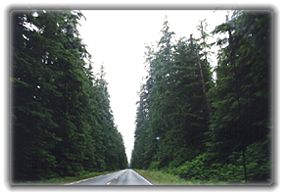 North
through Copalis Beach, Pacific Beach and Moclips. Here I'd hoped the
map was right and a thin line would take us back up to 101. Yes, there
was the road ... but wait, what did that sign say? Bridge out ahead.
So backwards we went. Round and about through Aloha and Humptulips ...
and we rejoined 101. And almost immediately we entered the Olympic National
Forest. The sign and the corridor of tall pines clued us in. North
through Copalis Beach, Pacific Beach and Moclips. Here I'd hoped the
map was right and a thin line would take us back up to 101. Yes, there
was the road ... but wait, what did that sign say? Bridge out ahead.
So backwards we went. Round and about through Aloha and Humptulips ...
and we rejoined 101. And almost immediately we entered the Olympic National
Forest. The sign and the corridor of tall pines clued us in.
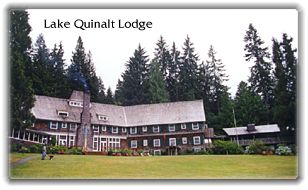 We
took a detour to Quinalt, might as well visit the Lake Quinalt Lodge
while we're here. It was drizzling (this was a rainforest, after all)
and hard to see much of the lake. We
took a detour to Quinalt, might as well visit the Lake Quinalt Lodge
while we're here. It was drizzling (this was a rainforest, after all)
and hard to see much of the lake. 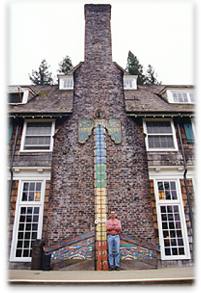 But
the Lodge was great — another similar to old national park lodges.
Cedar shingled; huge, comfortable, rustic interior. The grassy grounds
in back sloped down to the lake. We hung out for a while, took a walk
down to the water, then spent some time in the gift shop looking at
books. But
the Lodge was great — another similar to old national park lodges.
Cedar shingled; huge, comfortable, rustic interior. The grassy grounds
in back sloped down to the lake. We hung out for a while, took a walk
down to the water, then spent some time in the gift shop looking at
books.
Back
on 101 we were headed west again, to the ocean. It was time for another
beach stop in Queets. Wow, wow ... the driftwood! We'd seen scattered
large pieces in other areas, but nothing like this. I was excited. It
was a challenge climbing and navigating through it. How did all these
huge logs end up here? We would find
the answer just up the coast ...
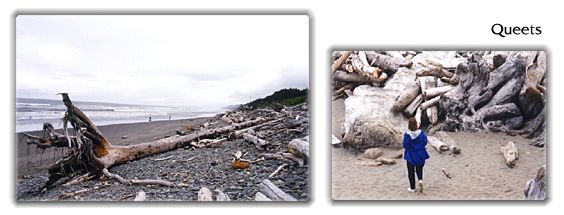
I was
going a bit crazy ... where's a truck when you need it? But calm down,
now. What could we carry home? We began finding medium-sized
pieces — masterpieces that nature had formed. When we could
hold no more, we climbed back to the car.
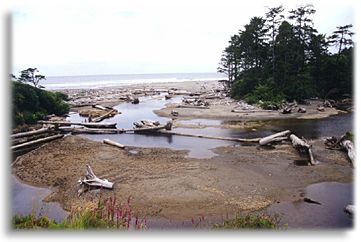 Just
a few miles ahead, we stopped at Kalaloch. There was a nice lodge, with
cabins along a hill above the ocean. A beautiful spot with tidepools,
more great wood, and the sun was making
its first appearance of the day — a wonderful confluence. Just
a few miles ahead, we stopped at Kalaloch. There was a nice lodge, with
cabins along a hill above the ocean. A beautiful spot with tidepools,
more great wood, and the sun was making
its first appearance of the day — a wonderful confluence.
We walked
along the rise above the beach.
A poetic sign explained the Drift Logs, not mere wood were they:
| Beach
logs are the bones of a rain forest picked clean by the sea —
giant conifers like Sitka spruce. When a day's downpour adds to
glacial melt, the stream may rise six feet, undermining the bank
and toppling trees into the flood, washing them down to river
mouth and beach. Some fall from eroding headlands. Numbered trunks
are strays from tug-pulled log rafts. |
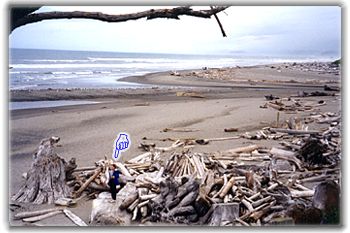 There
was also a warning that the logs could move at high tide, people had
been killed by them. I found them harmless and fascinating, amazing
sculptures. The light had taken on that sheer luminous quality that's
hard to describe. I've seen it mostly (and maybe exclusively) around
water ... (Nova Scotia's Minas
Basin and Lake
Powell come to mind), though each had a unique feel. A stunning
area, I spent quite a while photographing and just enjoying the wonder
and solitude. There
was also a warning that the logs could move at high tide, people had
been killed by them. I found them harmless and fascinating, amazing
sculptures. The light had taken on that sheer luminous quality that's
hard to describe. I've seen it mostly (and maybe exclusively) around
water ... (Nova Scotia's Minas
Basin and Lake
Powell come to mind), though each had a unique feel. A stunning
area, I spent quite a while photographing and just enjoying the wonder
and solitude.
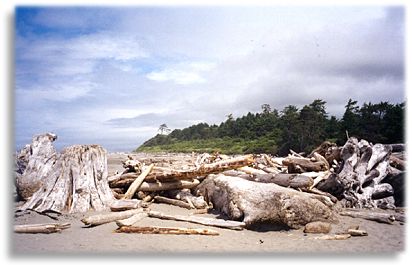
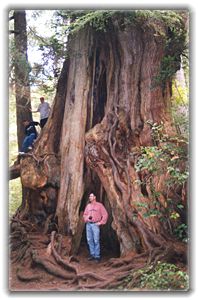 Not
long after we left Kalaloch, we saw a sign: Big
Cedar Not
long after we left Kalaloch, we saw a sign: Big
Cedar  So we
turned, and at the end of a short dirt road, indeed it was. A Big Cedar. So we
turned, and at the end of a short dirt road, indeed it was. A Big Cedar.
101 turned
east away from the coast and the weather began to deteriorate again
... such changes in short distances. As we arrived in Forks, the rain
was coming down steadily. Time for a shake-and-fries lunch while we
decided which way next.
Well,
it was sunny at the coast ... that's more than enough reason to take
a side trip west to La Push, an Indian fishing village 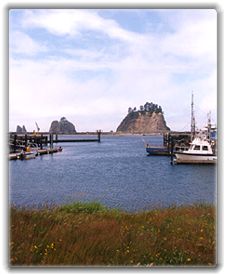 17
miles away. And as we'd come to count on, the weather did clear the
closer we got to the ocean. We came upon an unusual place. La Push was
the ancestral land of the Quileute Indians. There was a marina with
several fishing boats, a couple small stores, some modest homes and
not much more ... except, just offshore: the seastacks were everywhere!
In Oregon we'd seen haystacks ... Washington's answer was its seastacks.
The difference I noticed between them: these monoliths had trees and
other plant life growing on them. 17
miles away. And as we'd come to count on, the weather did clear the
closer we got to the ocean. We came upon an unusual place. La Push was
the ancestral land of the Quileute Indians. There was a marina with
several fishing boats, a couple small stores, some modest homes and
not much more ... except, just offshore: the seastacks were everywhere!
In Oregon we'd seen haystacks ... Washington's answer was its seastacks.
The difference I noticed between them: these monoliths had trees and
other plant life growing on them.
One of
the larger seastacks was James Island, home of an ancient village ...
I believe that's the wide monolith in the picture below. People were
going about their business around town as if there was nothing unusual
about the beautiful shore and
seascape ...
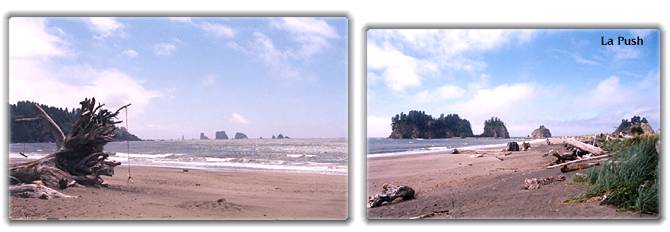

© 2000 CCarnovale
Home
| Web Design | Graphics
| Photos | Travels
|

 North
through Copalis Beach, Pacific Beach and Moclips. Here I'd hoped the
map was right and a thin line would take us back up to 101. Yes, there
was the road ... but wait, what did that sign say? Bridge out ahead.
So backwards we went. Round and about through Aloha and Humptulips ...
and we rejoined 101. And almost immediately we entered the Olympic National
Forest. The sign and the corridor of tall pines clued us in.
North
through Copalis Beach, Pacific Beach and Moclips. Here I'd hoped the
map was right and a thin line would take us back up to 101. Yes, there
was the road ... but wait, what did that sign say? Bridge out ahead.
So backwards we went. Round and about through Aloha and Humptulips ...
and we rejoined 101. And almost immediately we entered the Olympic National
Forest. The sign and the corridor of tall pines clued us in. We
took a detour to Quinalt, might as well visit the Lake Quinalt Lodge
while we're here. It was drizzling (this was a rainforest, after all)
and hard to see much of the lake.
We
took a detour to Quinalt, might as well visit the Lake Quinalt Lodge
while we're here. It was drizzling (this was a rainforest, after all)
and hard to see much of the lake.  But
the Lodge was great — another similar to old national park lodges.
Cedar shingled; huge, comfortable, rustic interior. The grassy grounds
in back sloped down to the lake. We hung out for a while, took a walk
down to the water, then spent some time in the gift shop looking at
books.
But
the Lodge was great — another similar to old national park lodges.
Cedar shingled; huge, comfortable, rustic interior. The grassy grounds
in back sloped down to the lake. We hung out for a while, took a walk
down to the water, then spent some time in the gift shop looking at
books.
 Just
a few miles ahead, we stopped at Kalaloch. There was a nice lodge, with
cabins along a hill above the ocean. A beautiful spot with tidepools,
Just
a few miles ahead, we stopped at Kalaloch. There was a nice lodge, with
cabins along a hill above the ocean. A beautiful spot with tidepools,
 There
was also a warning that the logs could move at high tide, people had
been killed by them. I found them harmless and fascinating,
There
was also a warning that the logs could move at high tide, people had
been killed by them. I found them harmless and fascinating, 
 Not
long after we left Kalaloch, we saw a sign: Big
Cedar
Not
long after we left Kalaloch, we saw a sign: Big
Cedar  17
miles away. And as we'd come to count on, the weather did clear the
closer we got to the ocean. We came upon an unusual place. La Push was
the ancestral land of the Quileute Indians. There was a marina with
several fishing boats, a couple small stores, some modest homes and
not much more ... except, just offshore: the seastacks were everywhere!
In Oregon we'd seen haystacks ... Washington's answer was its seastacks.
The difference I noticed between them: these monoliths had trees and
other plant life growing on them.
17
miles away. And as we'd come to count on, the weather did clear the
closer we got to the ocean. We came upon an unusual place. La Push was
the ancestral land of the Quileute Indians. There was a marina with
several fishing boats, a couple small stores, some modest homes and
not much more ... except, just offshore: the seastacks were everywhere!
In Oregon we'd seen haystacks ... Washington's answer was its seastacks.
The difference I noticed between them: these monoliths had trees and
other plant life growing on them.
